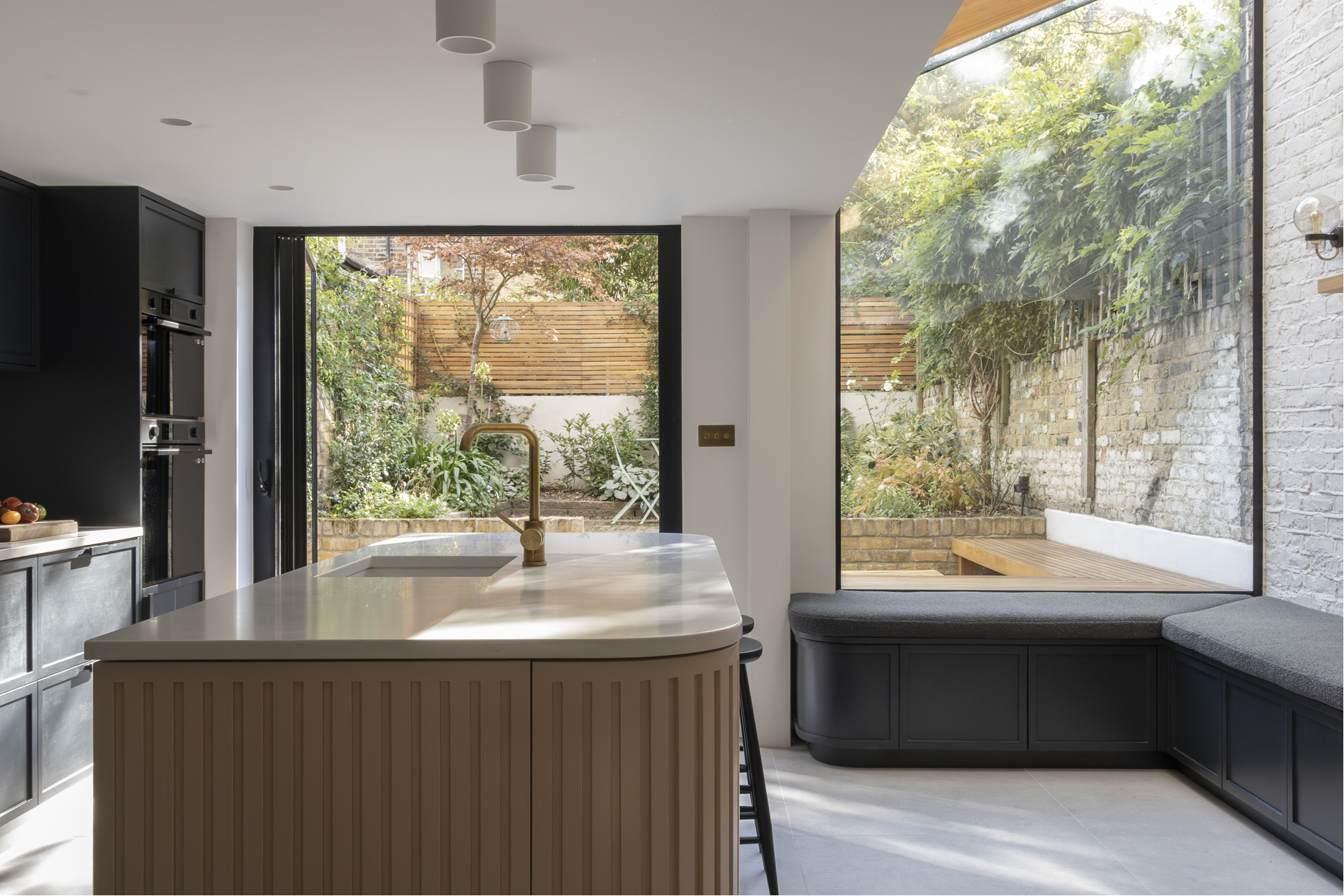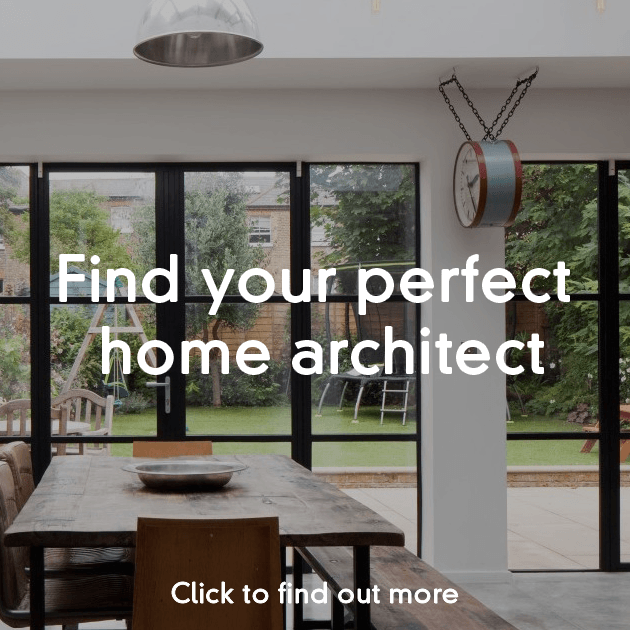Starting a home project is exciting, but the professional you appoint at the beginning will shape your budget, timescales and ultimately the quality of the result. In the UK the title “architect” is legally protected, yet even within that group there are many different types. Some are highly creative and design led, others are more technically minded, some have a strong focus on interiors, and others excel at project management.
On top of this, there are also other kinds of architectural designers and technologists who can offer overlapping but distinct services. It can feel overwhelming to know who is right for you, and this is where we come in: Design for Me helps match you with the best person for your project. This guide explains the options and shows how to align your brief with the professional best suited to deliver it with confidence.
Extension above by Anna, interior designer in London on Design for Me. See her full profile and shortlist her for your home project here.
Contents
- Why the type of architect matters
- Architects, technologists and designers compared
- Match your project to the right expertise
- Independent architect vs design and build
- Selection factors that matter
- Fees, cost control and value
- Approvals and who does what
- How to write a useful brief
- What the process looks like
- FAQs
- Next steps and free matching
1. Why the type of architect matters
Every project has a primary challenge. A loft conversion is often driven by structure, thermal upgrades and headroom calculations. A kitchen extension often hinges on planning risk, daylight, and how new meets old. A new build usually calls for a clear design vision and strong coordination from concept through to construction. Choosing a professional whose strengths align with your main challenge is the fastest route to a result you love and a build that runs smoothly.
If you are at the very start, it helps to understand what to look for when hiring. See our article What to look for when hiring an architect.
2. Architects, technologists and designers compared
There are four main categories of professionals who typically work on residential projects. Each brings different strengths and training, so it is important to understand how they differ.
Architects (ARB registered)
Architect is a protected title in the UK. Only those registered with the Architects Registration Board (ARB) can use it. Many also belong to the Royal Institute of British Architects (RIBA).
- Training: Around seven years of study and practical experience.
- Strengths: Well-rounded design skills, planning knowledge, project management and technical competence.
- Best suited to: Design led extensions, whole house renovations, new builds and projects with planning complexity.
Chartered Architectural Technologists (MCIAT)
Technologists specialise in the science and technology of building. They belong to the Chartered Institute of Architectural Technologists (CIAT) and must follow its Code of Conduct.
- Training: Typically 5–6 years to qualify.
- Strengths: Detailed drawings, technical compliance, energy performance and efficient construction methods.
- Best suited to: Loft conversions, simple extensions and projects where practicality and cost efficiency come first.
Architectural Designers and Technicians
These are broad titles not protected by law. Qualifications and experience vary, from part qualified architects to technicians or experienced draftspeople.
- Strengths: Can be a cost effective way to produce drawings and planning packs.
- Considerations: Always check credentials, insurance and references as competence varies widely.
- Best suited to: Straightforward planning applications or uncomplicated layouts.
Interior Architects and Interior Designers
The title of ‘Interior Architect’ is not formally recognised, but it is sometimes used by architects who specialise in interiors or by interior designers with architectural qualifications.
- Strengths: Space planning, finishes, furniture, lighting and the overall look and feel of your interiors.
- Best suited to: Interior renovations, kitchens, bathrooms and open plan living projects.
For further detail, see what is the difference between an architect, designer and technologist and what is an interior architect.
3. Match your project to the right expertise
Loft conversion
Main challenge: Structural upgrades, insulation, fire and escape, and tight headroom.
Best fit: Chartered Architectural Technologist or a technically focused architect.
Why: The technical constraints dominate. A creative eye still helps, particularly for dormer design and daylighting, yet compliance and buildability are the priority.
Rear or side extension
Main challenge: Planning sensitivity, daylight to neighbours, junctions with existing fabric, roof geometry.
Best fit: Creative architect if you want a distinct statement, technologist if you prefer a straightforward, cost efficient solution.
Explore inspiration and small project specialists: 10 of the best architects for small home projects.
Whole house renovation
Main challenge: Replanning within constraints, selective structural change, services upgrades and interior coherence.
Best fit: Creative architect or interior architectural designer. Many projects benefit from both design led thinking and disciplined technical detailing.
See also: Architect and interior designer – do I need both?.
Open plan living and knock throughs
Main challenge: Furniture layouts, natural light, flow, acoustics and storage. Structural input is needed where walls are removed.
Best fit: Interior designer or interior architectural designer plus a structural engineer as required.
Kitchen and bathroom only
Main challenge: Services coordination, ergonomics, finishes and procurement.
Best fit: Interior designer or interior architectural designer.
New build home
Main challenge: Comprehensive design and approvals from blank site to delivery.
Best fit: Creative architect if design vision is paramount. Technologist if zero carbon or cost performance targets lead the brief. The best teams balance both.
4. Independent architect vs design and build
You can hire an independent architect or choose a ‘one-stop-shop’ design and build company that includes design in its package. Each route has trade offs.
Independent architect route
- Greater control over design quality and specification
- Architect works for you, not the builder
- Competitive tendering can improve value
- Flexibility to change details prior to construction without heavy variation costs
Design and build route
- Early cost certainty and a single point of contact
- Faster mobilisation and simpler communication
- Potentially less design flexibility once the price is fixed
Read our balanced guide: Pros and cons of design and build.
5. Selection factors that matter
Their experience and portfolio
Look for comparable projects in scale, property type and planning context. Ask for references you can contact. Our checklist in what to look for when hiring an architect is a useful starting point.
Communication style and compatibility
This is a collaborative relationship between you as a client and your designer. Discuss how you prefer to make decisions, how often you want updates, and how designs will be presented. See questions to ask before hiring a designer.
Credentials and insurance
- Verify ARB registration for architects and CIAT for technologists
- Ask for evidence of professional indemnity insurance
References
Speak to past clients about responsiveness, cost control, and how issues were resolved on site.
Availability and timeline
Check their current workload and when design and site visits can realistically occur. Align expectations early.
6. Fees, cost control and value
Architects and designers typically charge one of three ways: percentage of construction cost, fixed fee by stage, or hourly rates. The right structure depends on scope certainty and your appetite for change as the design develops. See our guide how much does an architect cost for an extension.
Tips to protect your budget
- Be transparent about your maximum budget from day one
- Agree a scope and deliverables for each design stage
- Ask for early cost checks against the brief
- Use competitive tenders or at least comparable quotes
- Value engineer with your architect/designer before you sign a contract with a builder.
If funds are tight, read how to get the most value from your architect on a tight budget.
7. Approvals and who does what
Many residential projects will require at least one of the following. Clarify who will prepare drawings and manage submissions.
- Planning permission or a lawful development certificate
- Building control approval for technical compliance
- Party wall awards where works affect shared or neighbouring structures
- Freeholder consent for leasehold properties
During interviews ask how the designer will navigate these, what pitfalls they foresee and how they will mitigate risk. Our article 10 questions to ask an architect in an interview lists the key prompts.
8. How to write a useful brief
You do not need all the answers before you speak to a professional. Start with your objectives, the problems with your home today, any must haves, nice to haves and a top level budget. Photos and any existing plans are very helpful. See how to write an architectural brief for a simple step by step.
What to include
- Goals for space, light, storage and lifestyle
- Constraints such as conservation area, leasehold or tricky neighbours
- Timescales, such as a move in date or school term
- Design references that express mood, not only style labels
- Budget range, including a contingency line
9. What the design process looks like
Typical stages with an independent architect or technologist
- Feasibility and briefing – site visit, constraints audit, initial sketches and budget reality check
- Concept design – options that test layout, massing and appearance
- Planning submission – drawings and documents for approval where required
- Technical design – detailed drawings, specs and coordination with structural engineer and other consultants
- Tender – obtain and compare builder quotations on a like for like basis
- Construction and contract administration – quality, progress, valuations and change management
For smaller projects or where you want to move quickly, a design and build company can compress steps, although this usually fixes cost and specification earlier. Read the pros and cons of design and build before deciding.
Do you need a separate project manager?
Often you do not. A lead consultant such as your architect can act as contract administrator, while the main contractor manages the daily site programme. More on this in home extension project management.
10. FAQs
Do I always need an architect?
Not always. For interior only renovations, kitchen or bathroom refreshes and simple knock throughs, an interior designer or interior architectural designer can be the best fit, along with a structural engineer where needed. For extensions and new builds, an architect or technologist is usually advisable.
Is an interior architect different from an interior designer?
Interior architect is not a regulated title. It is often used by an ARB registered architect who focuses on interiors, or by an interior designer with architectural training. Always verify qualifications and insurance. See what is an interior architect?
How many professionals should I interview?
Two to three is ideal. Ensure they are available for your timeframe and experienced in similar projects. Use our interview questions to compare like for like.
Will design and build be cheaper?
Sometimes, yet not by default. Design fees are usually rolled into the lump sum. The gains are simplicity and early cost certainty. Changes after contract can be expensive. Our guide to design and build explains where it works best.
How are architect fees structured?
Percentage of construction cost, fixed fees by stage, or hourly rates are common. The right choice depends on scope clarity and your risk profile. See architect costs for an extension.
Should I use a builder’s in house designer?
It can be efficient for simple, repeatable work. If you want distinctive design or greater control over specification, an independent architect is often better aligned with your interests.
Can I do the interiors myself while an architect handles the shell?
Yes. Many clients split scope this way. Clarify responsibilities for coordination, especially for kitchens, bathrooms, lighting and services, so nothing falls between roles. If you later decide you want professional interiors help, read our article – architect or interior designer?.
Next steps and free matching
You will get better results if you shortlist professionals who genuinely match your brief. On Design for Me you can post your project for free and attract interest from architects, technologists and interior designers who are available and suitable.
Related reading
- What to look for when hiring an architect
- Questions to ask before hiring a designer
- How to write an architectural brief
- Pros and cons of design and build
- 10 questions to ask an architect in an interview
- What is an interior architect
- Architect and interior designer – do I need both
- Do I need a project manager for a home extension
- Do I need an architect or interior designer
- How much does an architect cost for an extension
- How to get the most value from your architect on a tight budget
- 10 of the best architects for small home projects



